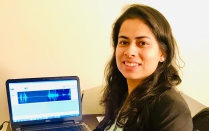Update from Anirban Dutta’s NIRlab: CGHE welcomes Visiting Research Assistant Yashika Arora!

Yashika Arora, Visiting Research Assistant.
By Lisa Vahapoğlu
Published January 15, 2020
At his Neuroengineering and Informatics for Rehabilitation Laboratory (NIRlab) in the Department of Biomedical Engineering, CGHE faculty member Dr. Anirban Dutta works with near-infrared spectroscopy (NIRS)—a non-invasive imaging technique in which light of a particular wavelength is applied to chemicals or biological subjects.
Doing so yields a picture of the organic composition of the analyzed substance, material or subject. (If you have ever had your blood pressure taken at a routine medical check-up, you might also have had a small clip placed on your index finger: a pulse oximeter, which uses NIRS to measure the oxygen in your blood). Additionally, the NIRlab works with the electroencephalogram (EEG), another widely-used, noninvasive test. EEGs detect electrical activity in the brain through electrodes attached to the scalp.
These technologies are used together by NIRlab. In one project supported by the Community for Global Health Equity (CGHE), NIRS and EEG are used to identify and monitor hypoxic-ischemic encephalopathy (HIE), which is injury to a baby’s brain at or near the time of birth that is caused by oxygen deprivation and shortage of blood flow to the brain. If not addressed, HIE can result in brain damage or death. However, if identified, HIE is treatable—even in low-resource environments—through temporarily lowering the body temperature of the neonate to slow the baby’s metabolism, which gives damaged cells an opportunity to recover.
For the past four months, NIRlab has been hosting visiting research assistant Yashika Arora, a neuroscientist who is pursuing a doctorate from the School of Computing and Electrical Engineering at Indian Institute of Technology, Mandi. Arora’s research interests in biomedical systems design and bio-signal processing fit well with the work of the NIRlab. Specifically, Arora’s doctoral work is on “clinico-anatomic correlations” (the circular process by which brain function can be inferred from clinical symptoms and structural imaging) of cerebral blood flow and neuronal activity. Specifically, she is developing a computational model to establish the relationship between local neural activity and changes in cerebral blood flow known as neurovascular coupling, or NVC.
Arora explains that “in order to correlate spatial and temporal changes between cerebral blood flow and neuronal activity, scientists work with several neuroimaging modalities—like EEG, NIRS, and, magnetic resonance imaging (MRI)—in combination.”
NIRlab and Arora’s research leverages affordable, non-invasive technologies, in keeping with CGHE’s aim to improve health and wellness in low- and middle-income countries.
Arora is at UB with the support of the Science and Engineering Research Board, a statutory body of the Department of Science and Technology, Government of India.

